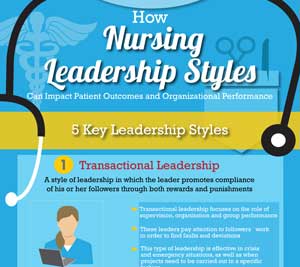Infographic: How Nursing Leadership Styles Can Impact Patient Outcomes and Organizational Performance

The following guest post on improving patient outcomes was submitted by Bradley University
As in any profession, nurses can only perform as well as their workplaces, teams, and managers allow. While all healthcare employees are responsible for an organization’s performances, nurses are in an important position to directly influence patients’ experiences and outcomes. But in healthcare, performance doesn’t just have consequences in patient satisfaction; it can also affect recording errors, medication errors, and ultimately patient mortality rates.
Since managers are in a position to directly control the environment in which nurses work, their leadership style can have a tremendous impact on how patients are cared for and how the organization performs as a whole. Research has found that there are distinct correlations in how each of five key leadership styles can positively — or negatively — sway the quality of care provided.
Leadership styles can be fluid, and there isn’t necessarily one correct approach which will suit every organization or situation. For example, transactional and authoritarian leaders can excel during emergency situations, whereas democratic leadership is at its best when collaborating to refine processes and workflows. Transformational leadership can inspire nurses to perform at their best, demonstrated by research indicating reduced patient mortality in three of six studies.
Learn more about these leadership styles with the infographic below, produced for Bradley University’s Online Nursing Program. This graphic gathers research examining the link between different management styles and how they can influence an organization’s performance and patient outcomes.



